Bio of Cancer Ch. 5 – Flashcards
Unlock all answers in this set
Unlock answersquestion
Chemical carcinogens were first discovered more than two hundred years ago
answer
-skin cancer of the scrotum from chimney soot -snuff (a powder tobacco) suffered nasal cancer -factories that produced aniline dyes increased bladder cancer. (first cancers known to be caused by a specific chemical)
question
How aniline dye industry was born
answer
-Perkin was attempting to synthesize quinine, a drug treated for malaria, by carrying out chemical reactions on substances present in coal tar. -in one experiment he extracted aniline from coal tar and oxidized it with potassium dichromate. -the dark sludge in alcohol yielded an intense purple solution that had strong dying properties. -discovery of aniline purple -the first synthetic dye -within a few years the coal tar yielded several other dyes and the aniline dye industry was born -2-naphthylamine is an ideal starting material for the synthesis of many dyes.
question
bladder cancer
answer
-employees working with 2-naphthylamine developed bladder cancer -in most cases the bladder cancer took 15-30 years to appear after being exposed to 2-naphthylamine
question
important principles that are relevant to chemical carcinogenesis.
answer
-involves the long delay that is typically between exposure to a chemical carcinogen and the onset of cancer -dose dependence: workers who were exposed to the chemical over a longer period of time, and hence has a longer total exposure, exhibited higher bladder cancer raters than workers with shorter exposure. (means not hereditary differences were not significant) -organ specificity that is common feature of the chemical carcinogenesis. ex. 2-naphthylamine->bladder cancer, aflatoxin ->liver cancer
question
asbestos
answer
-second most lethal commercial product (after tobacco) -organ specific -comes from a rock, when crushed yields a mixture of fine fibers that can be woven into materials that exhibit excellent insulating and fire-retarding properties. -fireproof clothing and other products have been made from asbestos -breaks down into tiny fibers called "needles of death" and are easily inhaled and become lodged in the lungs, where they cause scarring that kills people through suffocation. -development of lung cancer -ability to cause mesothelioma
question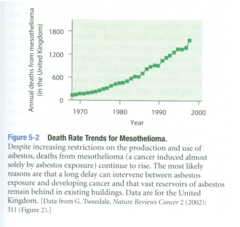
mesothelioma

answer
-rare form of cancer derived from the mesothelial cells that cover the interior surfaces of the chest and abdominal cavities. -increased risk exhibited by asbestos workers and by people who experience significant exposure to asbestos. -asbestos is the only clearly caused of mesothelioma -tiny fibers of inhaled asbestos become embedded in the lung and gradually penetrate completely through the ling tissue emerging into the chest cavity. -here the asbestos fibbers trigger a chronic irritation and inflammation that promotes the development of cancer of mesothelial cells.
question
risks from low-dose exposures to chemical carcinogens are difficult to assess
answer
-just because there is a very low chance does not mean it cannot happen -dioxins
question
dioxins
answer
-family of chlorinated chemicals produced as a by-product during the burning of municipal wastes, the bleaching of paper, and production of herbicides. -increased cancer rate of workers exposed to large concentrations of dioxin, animal studies as well. -although small quantities in the environment they are stable molecule that tend to persist for long periods of time, accumulating in the food chain -ex. fatty meats -experiment with rats show high dose cause cancer and low doses can sometimes decrease cancer compared to those observed in control animals. -data shows it is possible for a low dose carcinogen exposures to be safe, perhaps beneficial
question
organchlorine pesticides
answer
-a group that includes the now-banned insecticide dichlorodiphenyltrichloroethane (DDT) -compounds mimic the action of estrogen, which is known to promote the development of breast cancer -after a study, results failed to show a relationship of organochlorines in blood to women with breast cancer.
question
maximum tolerated dose (MTD)
answer
-in animal testing highest does that can be administered without causing serious weight loss or signs of immediate life-threatening toxicity. -at these high doses, many chemicals cause tissue destruction and cell death. -the remaining cells proliferate to replace those cells that have been destroyed, and this enhanced cell proliferation creates conditions that are favorable for the development of cancer.
question
threshold

answer
-dose must be exceeded before cancer rates begin to rise. -doses below the threshold would be safe in terms of cancer risks. -one possible explanation for the existence of thresholds is the ability of high-dose exposures to cause tissue destruction and cell death, which creates a unique set of conditions that do not exit at lower doses. -another reason is that carcinogens often act by causing DNA damage if low dose is given DNA repair mechanisms may be able to come in and repair damaged DNA Why do you need threshold? Bc you need to remove and break down carcinogen
question
the hormetic model shows that a VERY low doses of carcinogen, the cancer rates may actually decline. why should this be possible?
answer
a small daily dose of carcinogen can induce liver enzymes
question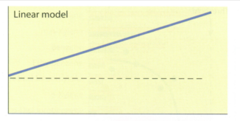
linear model

answer
-linear dose response relationship with no threshold
question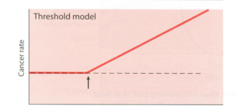
threshold model

answer
assumes no cancer risk at lower doses followed by a linear dose-response relationship at higher doses.
question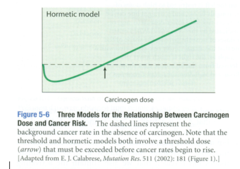
hormetic model

answer
-proposes that dose-response curves can also be U-shaped. -U shaped known as hormesis, reflects a situation in which cancer rates actually decline at very low doses of carcinogen and then being to go up as the dose is further increased.
question
Cancer chemotherapies such as cyclophosphamide cause leukemias, bladder cancers
answer
modern version of mustard gas. used as a chemotherapy
question
2-acetylamainofluorene (AAF)
answer
-potent carcinogen in rats but does not cause cancer in guinea pigs -AAF is actually a precarcinogen that needs to be metabolically activated before it can cause cancer. -rats, but not guinea pigs, contain the enzyme that catalyzes this metabolic activation. -biochemical analysis in human tissues has showed we contain this enzyme as well -if this was only tested in guinea pigs it would of never have been a carcinogen in the first place
question
diethylstilbestrol (DES)
answer
-synthetic estrogen that was prescribed to pregnant women starting in the 1940s as a way of preventing miscarriages. -development of vaginal cancers -drugs ability to cause cancer did not become apparent until decades later, and did not effect the person who took it but rather the children
question
immunosuppressive drugs
answer
-inhibit immune function and are given to organ transplant patients to prevent rejection of the transplanted organ, such a heart of kidney. -two most common drugs are azathioprine and cyclosporin
question
rapamycin aka sirolimus
answer
-antibiotic with immunosuppressive activity -besides suppressing immune function, rapamycin inhibits tumor growth -inhibits angiogenesis, noth by depressing the production of VEGF and by inhibiting the ability of endothelial cells to respond to VEGF (promotes angiogenesis) -suppression of angiogenesis by rapamycin may therefore limit the ability of newly forming tumors to obtain the blood supply they require for growth beyond a tiny size.
question
chemical carcinogens can be grouped into several distinct categories
answer
most are natural or synthetic organic compounds range from small organic molecules containing only a few carbon atoms to large, complex molecules constructed from multiple-carbon containing rings. -vast majority fall into 5 categories
question
1. carcinogenic polycyclic aromatic hydrocarbons aka polycyclic hydrocarbons (PAHs)

answer
-diverse group of compounds constructed multiple fuzed benzene rings -natural components of coal tars, soots, and oils, and also produced during the incomplete combustion of coal,oil, tobacco, meat, and just about any organic material that can be burned. -potency varies widely from weak or noncarcinogenic molecules to very potent carcinogens. -benzo[a]pyrene and dibenz[a,h]anthracene, isolated from coal tar and first purified chemical carcinogens of any kind to be identified -produced by combustion and proalaysis of meats
question
2. carcinogenic aromatic amines

answer
-organic molecules that posses amino group attached to a carbon backbone containing one or more benzene rings. -2-naphthylamine, 2-acetylaminofluorene, and 4-aminobiphenyl, and the aminoazo dyes 4-dimethylaminoazobenzene and o-aminoazotoluene -many were once employed in the manufacturing of dyes, although most are no longer used in significant quantities because of their toxicity. -some vary to strong carcinogenic to substances that are not carcinogenic at all
question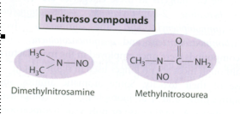
3. carcinogenic N-nitroso compounds

answer
-organic chemicals that contain a nitroso group (N=O) joined to a nitrogen atom. -members include nitrosamines and nitrosoureas, which are potent carcinogens tested in animals -most are industrial or research chemicals encountered mainly at a workplace, although a few present in tobacco smoke. -nitrates and nitrites, used in the curing of meats, which are not carcinogenic themselves, but can be converted in the stomach into nitrosoamines, but no consistent relationship between these compounds and humans cancer has been established.
question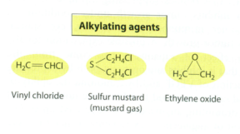
4. carcinogenic alkylating agents

answer
-molecules that readily undergo reactions in which they attach a carbon containing chemical group to some other molecule. -defined not only by structure, but by their chemical reactivity. (ability to join a chemical group to another molecule) -vinyl chloride (used in production of plastics), ethylene oxide (used in the production of antifreeze and other chemicals) vinyl chloride and ethylene oxide are among the highest volume chemicals produced in the US. -others include sulfur mustard (a chemical warfare agent) and several drugs used in chemotherapy
question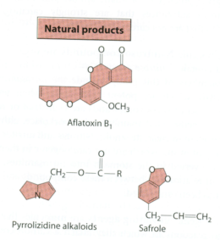
5. carcinogenic natural products

answer
-structurally diverse group of cancer cause molecule produced by biological organisms, mainly microorganisms and plants. -aflatoxin, a carcinogenic chemical made by the mold aspergillus, sometimes contaminates grains and nuts that have been stored under humid conditions. -safrole, major component of sassafras root bark, and pyrrolizidine alkaloids, produced by different plants -bruised celery produces what natural product carcinogen? pyrrolizidine alkaloid -nitrate/nitrite poisoning, like beets, eggplant, lettuce, radish, spinach, and collard
question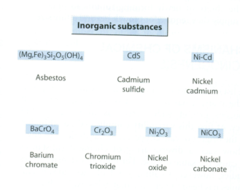
inorganic substances

answer
-in addition to the five groups a small number of inorganic substances are carcinogenic. -compounds containing metals cadmium, chromium, and nickel. -some inorganic substances appear to be carcinogenic in the absence of chemical reactivity -ex. absestos composed of silicon, oxygen, magnesium, and iron but its ability to cause cancer is related to the crystal structure and the size of microscopic fibers it forms rather than their precise chemical makeup
question
some carcinogens need to be activated by metabolic reactions occurring in the liver
answer
-2-naphthylamine, ability to cause bladder cancer, when injected directly in the an animals bladder it rarely caused cancer. -reason is when 2-naphthylamine is ingested (by animals) or inhaled (by humans) it first passes through the liver and is metabolically converted into chemical compounds that are the actual causes of cancer. injecting it directly into the bladder bypasses the liver and the molecule is never activated.
question
precarcinogens
answer
-term referring to any substance that is capable of causing cancer only after it has been metabolically activated. -the activation of precarcinogens is generally carried out by liver proteins that are members of the cytochrome P450 enzyme family
question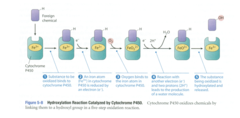
cytochrome P450

answer
-one of the functions of these liver enzymes is to catalyze the oxidation of ingested foreign chemicals, such as drugs and pollutants, with the aim of making molecules less toxic and easier to excrete from the body -the hydroxylation reaction is one of several ways in which cytochrome P450 oxidizes foreign chemicals to make them more water soluble, thereby facilitating their excretion in the urine. -occasionally, oxidation reactions catalyzed accidentally covert substances into carcinogens. this is known as carcinogen activation
question
carcinogen activation
answer
-evidence that cytochrome P450 is involved in carcinogen activation has come from numerous animal studies -one set of experiments involved a mutant stain of mice that produce abnormally large amounts of cytochrome P450 1A1, a form of cyctochrom P450 that oxidiizes polycyclic hydrocarbons. -as would be expected if cytochrome P450 1A1 were involved in carcinogen activation, cancer rates are elevated in the mutant mice that produce large amounts of this enzyme. Cancer rates can be reduced to these same animals by using inhibitors that block the activation of cytochrome P450 1A1
question
cytochrome P450 1A1
answer
-elevated amounts of cytochrome P450 1A1 are found in the livers of people who smoke cigarettes, bc tobacco smoke stimulates production of the enzyme by the liver.
question
What is the evidence in mice that P450 plays a role in activation of carcinogens?
answer
-cytochrome is in mitochondria as well as P450 which allows you to knock out the mice
question
electrophilic
answer
-when metabolized in the liver, they are converted into highly unstable compounds with electron-decficient atoms. -electron-loving -they readily react with substances possessing atoms that are rich in electrons -DNA, RNA, and proteins all have electron-rich atoms, making each a potential target for electrophilic carcinogens. -attracted by epoxides, positively charged nitrogen atoms, or carbon atoms, or compounds containing an unpaired electron. like epoxides these electrophilic groups also attack electon-rich atoms in DNA
question
DNA prime candidate
answer
-DNA is a prime candidate bc the Ames test has shown that most carcinogens cause DNA mutations -in an experiment to show this, animals were injected with various polycyclic hydrocarbons that differed in carcinogenic potency. -cells were then isolated from the treated animals and measurements were made to determine which intracellular molecules (if any) had become bound to the polycyclic hydrocarbons. -data revealed a direct relationship between the carcinogenic potency of different polycyclic hydrocarbons and their ability to become covalently linked to DNA, in other words, those polycyclic hydrocarbons that became extensively bound to DNA were the most effective at causing cancer
question
Before a polycyclic hydrocarbon can interact with DNA it must be activated. Consider benzo[a]pyrene
answer
-normally a nonreactive, nonmutagenic compound. -after entering the body, metabolic reactions catalyzed by cytochrome P450 in the luver convert benzo[a]pyrene into activated derivatives containing an expoxide group. (reacts with atoms that are electron rich) such as the amino nitrogen found in the DNA base guanine
question
DNA adduct
answer
-reaction of the epoxide group with guanine cause the benzo[a]pyrene to become covalently bonded to DNA, thereby forming a DNA-carcinogen complex called DNA adduct. -the presence of the bound carcinogen distorts the DNA double helix and thereby causes errors in base sequence (mutations) to arise during DNA replication.
question
epoxide formation
answer
-also involved in the activation of other classes of chemical carcinogens -ex. aflatoxin and vinyl chloride -various epoxides do not all react with the same DNA bases.
question
What two compounds other than PAHs are converted into DNA reactive epoxides?
answer
benzo[a]pyrene and aflatoxin
question
chemical carcinogenesis is a multistep process
answer
-idea was first proposed by Rous to explain a phenomenon he encountered when studying the ability of coal tar to cause cancer is rabbits. -he observed that repeated application of coal tar to rabbit skin caused tumors to develop, but the tumors disappeared when application stopped. -after application of an irritant such as turpentine, which does not induce cancer by itself, caused the tumors to reappear. -this pattern suggested that coal tar and turpentine play different roles which he called initiation and promotion
question
initiation
answer
-converts normal cells to a precancerous state -an agent (chemcial, virus, xray) has caused a mutation in DNA, often a single base alteration
question
promotion
answer
-then stimulates the precancerous cells to divide and form tumors. -altered gene expression producing clonal expansion of an initiated cell -most promoters do not bind directly to DNA, nor cause mutations. -they are all usually mitogens ex. bile acids, phenobarbitol, dioxins, now known that inflammation activates STAT3, a tumor promoting transcription factor (proliferation)
question
Because coal tar is a mixture of various chemicals, clarification of the initiation/promotion hypothesis required the isolation and study of individual coal tar components
answer
-one chemical is the polycyclic hydrocarbon dimethylbenz[a]anthracene (DMBA) -if the skin of a mouse fed a single dose of DMBA is later painted with a substance that causes skin irritation, cancer develops in the treated area. -besides turpentine, the irritant most commonly used for triggering formation in such experiments is croton oil, a substance derived from seeds of the tropical plant croton tiglium -these observations support the concept that chemical carcinogenesis is a multi-step process in which an initiator (in this case DMBA) first creates an altered, precancerous state and then a promoting agent in this case (croton oil) stimulates the developing tumors.
question
the initiation stage of carcinogenesis is based on DNA mutation
answer
-bc the carcinogenic potency of most chemicals correlates with their ability to bind to DNA and cause mutations, the permanent alteration is thought to be a mutation
question
genotoxic
answer
carcinogens that bind to DNA and cause mutations. -cause gene damage -the ability to cause gene damage explains how a single exposure to an initiating carcinogen can create a permanent, inheritable change in a cells properties
question
methylnitrosourea
answer
-attacks base guanine in DNA, creating a methylated guanine derivative if cells DNA is replicated before repair mechanisms correct the defect, the methylated guanine tends to form an incorrect base pair with thymine during DNA replication rather than pairing with its correct partner cytosine. -during next round of replication the incorrectly inserted T will form a base pair with its normal complementary base A creating AT base pair. -the DNA molecule now contains an AT pair where GC base had originally existed. Since DNA repair mechanisms would not recognize anything abnormal about AT base pair, the error will persist.
question
tumor promotion involves a prolonged period of cell proliferation
answer
-in contrast to initiation, which requires only a single exposure to an initiating carcinogen, promotion is a gradual process that depends on prolonged or repeated exposure to a promoting agent -if the promoting agent is removed during the early stages of tumor formation, tumors stop growing and may even disappear
question
how do we explain the ability of promoting agents to trigger an event that is potentially reversible, at least in its early stages?
answer
-studies of a wide variety of promoting agents have revealed that their main shared property is the ability to stimulate cell proliferation -when an initiated cell is exposed to a promoting agent, the cell starts dividing and the number of initiated cells increases. -in early stages cell proliferation depends on presence of the promoting agent, and cells will stop dividing if the agent is removed. -as cell division continues natural selection favors those newly forming cells whose proliferation is faster and autonomous, eventually leading to the formation of a malignant tumor whose growth no longer depends on external promoting agents.
question
phorbol esters
answer
-the way in which specific promoting agents stimulate cell proliferation was first established for phorbol esters. -class of tumor promoters found in croton oil -most potent phorbol ester is tetradecanoyl phorbol acetate (TPA)
question
protein kinase C
answer
-TPA binds and activates this enzyme -plays a key role in one of the cells normal pathways for controlling cell proliferation -in normal operation of this pathway, external signaling molecules bind to cell surface receptors whose activation leads to the production of an intracellular signaling molecule called diacylglycerol (DAG)
question
DAG
answer
-activates protein kinase C, which triggers events leading to cell division -phorbal esters mimic the action of DAG, binding to and activating protein kinase C. -unlike DAG which is converted to inactive forms, phorbol esters continually activate the protein kinase C molecule -activation of protein kinase C by TPS is a highly selective interaction -small changes in the chemical structure of TPA yield derivatives that exhibit diminished ability to bind to protein kinase C and as a result decreased ability to function as a tumor promoter
question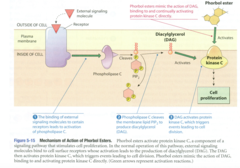
mechanism of action of phorbol esters

answer
-whenever you do not have a promoter you have a mitogen -promoter causes division and initiator causes mutation. makes phorbol ester a promotor -phorbol ester goes through cell membrane bc its an oil. binds to key enzyme protein kinase C adds a phosphate -DAG add directly to cell
question
other foreign substances stimulate cell proliferation and thereby act as promoting agents
answer
-fungal toxin teleocidin -algal toxin aplysiatoxin -function by activating protein kinase C -other stimulate cell proliferation indirectly, causing tissue damage and cell destruction that make is necessary for the remaining cells of the affected tissue to proliferate to replace the cells that have been damaged and destroyed. ex. asbestos and alcohol
question
molecules produced by the body for the purpose of stimulating normal cell division may also function accidentally as tumor promoters
answer
-ex estrogen -naturally produced steroid hormone that can contribute to the development of breast and ovarian cancer by stimulating the proliferation of cells in these tissues. -the hormone testosterone stimulates the proliferation of cells in the prostate gland and play a comparable role in promoting the development of prostate cancer. -if breast or prostate cell has acquired an initiating mutation caused by carcinogen or by an error in DNA replication , any normal hormone or growth factor that stimulates the proliferation of the mutant cell will act accidentally as a tumor promoter
question
tumor progression
answer
-third step discovered in chemical carcinogenesis -follows initiation and progression -gradual changes in the properties of the proliferating tumor cell populations that occur over time as cells acquire more abnormal traits and become increasingly aggressive. -explanation is that cells exhibiting traits that confer a selective advantage for ex. increased growth rate, increased invasiveness, ability to survive in the bloodstream, resistance to immune attack, ability to grow in other organisms, resistance to drugs, and evasion of death-triggering mechanisms (apoptosis) these will be more successful than cells lacking these traits and will gradually become predominate
question
clonal selection
answer
-if a particular mutation causes a cell to divide more rapidly, cells produced by the proliferation of this mutant cell will outgrow their companions and become the predominant cell population in the tumor clone- a pop of cells derived from a single initial cell by successive rounds of cell division
question
epigenetic change
answer
-refer to any such alternation in gene expression that does not involve mutating the structure of the gene itself. -activating or inhibiting the transcription of individual gene into mRNA is especially important in cancer cells -ex. many of the traits required for cancer cell invasion and metastasis are produced by epigenetically turning on and off the transcription of normal genes rather than by gene mutation -easier to reverse
question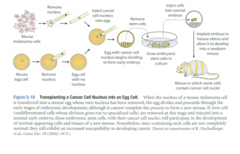
the question therefore arises as to whether a cancer cell can be epigenetically reprogrammed to reverse some of the changes responsible for malignant behavior

answer
-in an experiment you transfer the nucleus of a cancer cell into a different cytoplasmic environment to see if its gene expression patterns can be converted to a more normal state
question
carcinogen
answer
-a chemical capable of causing cancer that can vary in complexity from simple metals (chromium) to complex organics.
question
carcinogen agent
answer
-any agent that is capable of causing transformation -includes: chemicals radiation biological agents
question
monooxygenases
answer
aka mixed function oxygenases -found in all cells, but in high concentration in liver cells -induced and react with a die variety of chemicals, but especially hydrophobic and lipophilic insoluable hydrocarbons. the body is attempting to solubilize these often noxious chemicals so that they can become secreted. however, the oxidized/solubilized hydrocarbons become reactive with DNA bc of the action of monooxygenases
question
promoters
answer
substances that speed up cell division, neither mutagenic nor carcinogenic themselves, but they cause proliferation of the mutated cancer cell so that some its offspring may survive. ex. steroids
question
complete carcinogen
answer
-a direct acting substance which acts as both initiator and promoter. these are mutagenic substances which not need metabolic activation. ex. methyl methane sulfonate
question
incomplete carcinogen
answer
-referring to a chemical that exerts only one of these actions. (promoter or initiator)



